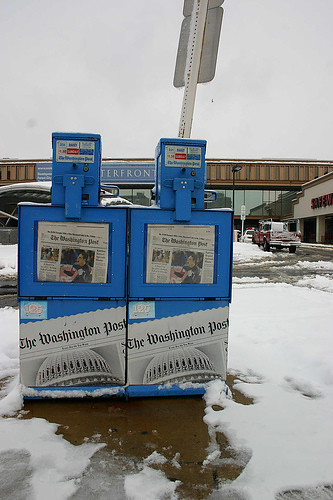The Washington Post editorial page caves in to the Growth Machine twice in the last two weeks
 It might take a snowy day in June for the Washington Post to buck the Growth Machine. Photo by Elvert Barnes.
It might take a snowy day in June for the Washington Post to buck the Growth Machine. Photo by Elvert Barnes.Newspapers are part of the Growth Machine, that's just the way it is.
The Washington Post's then publisher, Philip Graham, was one of the founders of the Federal City Council (read this article, "THE DISTRICT'S POWER BEHIND THE SCENES Washington Post-connected business group wields influence over city's legislative agenda," for what the FCC is about), and his son, Donald Graham, the current publisher of the paper, is a member of the Council today.
There is a joke about the Wall Street Journal that it's two papers in one, an incredibly conservative editorial page, and an interesting and wide-ranging business newspaper comprised of the other pages of the paper.
Maybe the Post evinces a similar kind of bifurcation.
On various subjects, the Post editorial page sidles up to the Growth Machine time and time again, even if more balanced coverage on the same issues makes up the gist of the day-in day-out reporting. One example recently was the editorial that came down favorably on the Inter County Connector in Montgomery and Prince George's County, which I commented on in this blog entry, "Interesting difference of opinion between the Baltimore Sun and the Washington Post on the Inter County Connector."
Another example was in January, when the Post editorialized, in "The Cost of a Fight," against reimbursing the people in Clarksburg, Maryland for the $500,000 they spent to prove that the developer and the Montgomery County Planning Office weren't following agreements and planning and zoning requirements. To me, this means that the Post believes that the only people allowed to challenge developers are those that can afford to do so out of their own pocket. So much for democracy and ensuring that government and businesses follow the law.
Anyway, there are two more recent examples from the last 10 days:
1. Today the Post editorialized in favor of above-ground parking garages at the Washington Nationals baseball stadium, in the editorial "Lots of Disagreement," even though that is counter-productive to creating a great place. The Post used the same Stan Kasten quote I used yesterday, where he arrogantly points out that only he has experience building a stadium, not the DC politicos. Yet if you look at yesterday's photos of Turner Field, he constructed a building, but didn't create a place. If he cared about cities, I can't imagine he'd be so proud of the freeways and parking lots that surround his creation.
 Turner Field, Atlanta, built by Stan Kasten. Note the car-centric barren areas around the stadium.
Turner Field, Atlanta, built by Stan Kasten. Note the car-centric barren areas around the stadium.2. Last week, the Post called for Mayor Williams to step in and help negotiate between neighbors and George Washington University over disagreements about the validity of efforts to change the GWU Campus Plan, in the editorial "Town vs. Gown in D.C." with the subtitle "GWU's planned $250 million commercial and office development sparks Foggy Bottom opposition."
These disagreements have led the neighbors to sue the City and the University. Doesn't the Post understand that the reason the neighbors are suing is because the City Government has already made its position clear?
From "Sport News in the Local Media - Green Bay Packers' Return to Glory," by Doobo Shim, National University of Singapore, The Sport Journal, 8:4, Fall 2005.
For the past several decades, local news media institutions have concerned themselves with suburbanization, and the weakening of citizens’ attachment to the city—phenomena that could possibly lead to a loss of readership and audiences (Kaniss, 1991; Friedland and McLeod, 1998). In order to overcome this, local media have made efforts to promote civic pride and local identity among citizens. In alliance with other community groups, local media campaign for increased membership in literary circles, sports clubs and Lions Clubs, and for greater voter turnout during elections, which are considered indices of the abundance of social capital in a locality. In order to create symbolic capitals in the community, the local media often sponsor the construction of major public works. In a sense, local media is part of what Harvey Molotch calls the “growth machine,” which refers to the “apparatus of interlocking progrowth associations and governmental units” (Logan and Molotch 1987, p. 32). The foremost aim of the growth machine is to facilitate a value-free development of the community so that there are more jobs for citizens, improved urban services, etc. Since their major financial sources are in the local arena, the aggregate growth of a community directly affects the existence of the local media, and the media’s acquisition of greater readership and sale of more advertisements.
Index Keywords: Growth-machine; media



0 Comments:
Post a Comment
<< Home